How to Budget for an Italy Trip
 After more than four years of work on WhyGo Italy, and as the number of comments and emails increases each month, there are themes that have developed in terms of what people ask me. I’ve gotten some off-the-wall questions, but the vast majority of the questions that come in fall into one of two categories – itinerary questions or budget questions.
After more than four years of work on WhyGo Italy, and as the number of comments and emails increases each month, there are themes that have developed in terms of what people ask me. I’ve gotten some off-the-wall questions, but the vast majority of the questions that come in fall into one of two categories – itinerary questions or budget questions.
I’ve written about what I think is the ideal 2-week Italy itinerary for a first-time visitor, and I’ve written about how to create the perfect Italy itinerary no matter where you want to go in the country. But I haven’t written much about budgeting for an Italy trip – partly because it’s a challenging question to answer in a way that satisfies every traveler.
Italy hasn’t been a cheap destination by most standards since the country switched currency from the lira to the euro (oh, those heady days when small souvenirs cost L30,000, when that huge number would only drain your wallet by $15), and I know people who have skipped Italy while traveling RTW simply to stretch their travel budgets further. It’s certainly possible to spend a fortune on a trip to Italy, and it’s also possible for a budget traveler to visit the country without going into debt. How much you spend on an Italy trip depends largely on how you travel.
Because it’s difficult (if not impossible) to lay out one formula for an Italy travel budget that will work for every traveler, I’m going to go through the things you need to think about when you’re determining how much an Italy vacation will cost. You’ll also find tips to save money on your trip, and a few instances when I think it makes sense to splurge.
Please keep in mind that many figures listed here are estimates, prices can change frequently and without notice, and these numbers shouldn’t be taken as the gospel for anything. This is meant to give you some ballpark figures, but you absolutely need to do some of your own clicking around to see what the actual going rate is when you’re planning your own trip.
>> Further reading – How to Visit Italy on a Budget
How to Figure Out What an Italy Trip will Cost
Airfare
 The cost of a flight to Italy can vary considerably, usually depending most on two factors – when you intend to fly, and where you’re flying from. The most expensive time to fly to Italy is the high summer season, which usually runs from mid-May through mid-September (with a slight dip in August sometimes), and as you might guess the cost of a ticket goes up the further away your home airport is from Italy.
The cost of a flight to Italy can vary considerably, usually depending most on two factors – when you intend to fly, and where you’re flying from. The most expensive time to fly to Italy is the high summer season, which usually runs from mid-May through mid-September (with a slight dip in August sometimes), and as you might guess the cost of a ticket goes up the further away your home airport is from Italy.
Generally speaking, airfare will be cheapest during the winter months – in January and February especially it’s not uncommon to see seriously discounted fares to Italy. If cold weather isn’t your idea of a great Italy trip, however, you’ll usually find the best equilibrium between good weather and lower prices on airfare if you plan your trip for the shoulder season months – in Italy, that’s typically March, April, and October.
For no discernable reason, Italy airfare from North America is often more expensive than airfare to other countries in Western Europe. If budget is your primary concern in travel planning, you can look at flying into a major international airport like the ones in London, Paris, Amsterdam, or Frankfurt – if you find a particularly great deal on a flight to one of those countries, then you can look for a second flight on a budget airline that flies to Italy to get you the rest of the way there.
When you’re planning an Italy trip, set up an alert on the airfare booking site of your choice so you’ll know what the going rate is for airfare and you’ll know when prices drop. Look at multiple Italy airports, too, as airfare to Milan or airfare to Venice is sometimes cheaper than airfare to Rome.
What will airfare to Italy cost?
In the summer, you can expect to pay $600 or more to fly round-trip from New York to Rome, and more than $1000 to fly to Rome from San Francisco. On the flip side, it’s not uncommon to see winter fares from the U.S. east coast to various cities in Italy that are less than $300 round-trip (winter fares from the west coast are still higher, but they start closer to the $600-800 range). Since this is the biggest part of your travel budget, it pays to do your research here to make sure you’re getting the best deal.
>> Further reading: How to Find Cheap Airfare to Italy, Cheap Airfare to Rome, Cheap Airfare to Milan, Cheap Airfare to Venice, How to Fly on Budget Airlines to Italy
Accommodation
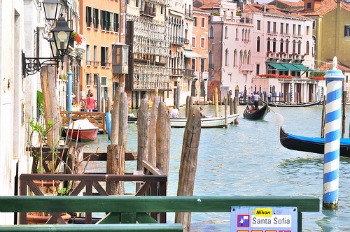 This is one of the parts of your Italy travel budget with the widest potential for variance, but most of the factors that make the cost of Italy accommodation vary are within your control.
This is one of the parts of your Italy travel budget with the widest potential for variance, but most of the factors that make the cost of Italy accommodation vary are within your control.
As is the case with airfare, accommodation costs fluctuate quite a bit depending on when you’re traveling. Hotels and hostels in Italy tend to be at their peak cost-wise during the summer months, and also around major holidays. In particular, the holidays of Easter, Christmas, New Year’s, and (in Venice) Carnevale are times when accommodation prices go up – but every city and region has smaller festivals and events that can make the prices go up as well. Paying attention to the holidays and events calendar for Italy will help you at least understand why room rates seem higher than usual.
The type of accommodation you’re looking at will also have an impact on how much your room costs. Opting for a bunk in a 6-bed hostel dorm will clearly cost far less than a double room in a 3-star hotel with an en suite bathroom – but since there aren’t any strict regulations regarding how much a hotel or hostel can charge based on the number of stars or rooms or amenities it has, it’s impossible to give solid figures for what the cost difference will be. Not only that, there are several other options besides the traditional hostels and hotels for you to choose from in Italy – including B&Bs, pensioni, camping, vacation rentals, agriturismo, etc.
What will accommodation in Italy cost?
On the budget end of things, hostel beds range from $15/night up to $40/night depending on the city you’re visiting and the month you’re traveling. Midrange hotels (2-3 stars) can be between $60/night to $200/night (and of course you can pay far more than that if you’d like!). Staying in less-popular cities, or away from the main attractions, can make the price drop significantly. To save even more in major cities, look for the word “camping” – campsites in big cities are often just outside the city center and nothing like the tents-and-campfires scenario most of us think of when we hear the word. In the countryside, consider renting an apartment or staying in an agriturismo.
>> Further reading: Different Types of Accommodation in Italy, What the Italy Hotel Star Rating System Means, What Italian Agriturismo Means, learn about vacation rentals in Italy, search for Italy hotels, search for Italy hostels
In-Country Transportation
 Italy gives you lots of options when it comes to how to get around – and the best mode of transportation for your trip will depend largely on where you’re going and how many people you’re traveling with. A solo backpacker sticking to larger cities and towns can get along just fine with trains and (sometimes) buses, but a family or group of 4+ venturing into the countryside will likely need to rent a car.
Italy gives you lots of options when it comes to how to get around – and the best mode of transportation for your trip will depend largely on where you’re going and how many people you’re traveling with. A solo backpacker sticking to larger cities and towns can get along just fine with trains and (sometimes) buses, but a family or group of 4+ venturing into the countryside will likely need to rent a car.
Train tickets in Italy used to be cheaper than they are now, but getting around Italy by train still tends to be the best combination of convenient and cost-effective. Whether an Italy Rail Pass or point-to-point tickets is the better option for you requires that you have a tentative itinerary in mind and that you do some math to compare costs. (It’s easy to do, it just takes a little figuring.) Using the bus is often even cheaper, but buses in Italy aren’t country-wide, so getting from (for instance) Rome to Venice by bus is more challenging than it’s worth.
Driving in Italian cities can be a huge headache, and outside the cities it can be the best way to get around. If your itinerary is mainly larger cities and towns but you’d like to spend a few days driving aimlessly in (let’s say) Tuscany or Sicily or Piedmont, you can very easily use Italian rail for the majority of your trip and rent a car for just the few days you need it. This option can make renting a car feasible even to budget travelers, for whom car rentals are usually too costly to consider. Note that the cheapest cars available for rent are manual transmission – automatic cars cost more. Also keep in mind that there are some “train + drive” rail passes that include a few days of a car rental in addition to train travel.
What will transportation in Italy cost?
An Italy Rail Pass good for seven days of train travel within two months costs $307 for 2nd class and $379 for 1st class (there are other options, from three days to 10 days, and passes for those 26 years and younger are cheaper). The cost of train tickets is impossible to narrow down to one figure, but it’s easy to figure out how much tickets will cost for any given route you want to travel. Rome-Venice, for instance, can be €90 in 1st class on the high-speed train or €40 for 2nd class on a slower train. An economy-sized manual transmission car rented in Florence for a few days of exploring in Tuscany can cost as little as $50/day in the high season (it can be closer to $40/day in the shoulder season).
>> Further reading: Getting Around Italy: What You Need to Know, Train Travel in Italy, When to Buy an Italy Rail Pass, When to Buy Italy Train Tickets, First Class vs. Second Class on Italy Trains, Bus Travel in Italy, Renting a Car in Italy, Driving in Italy
Meals
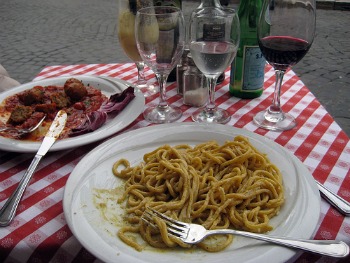 Even if you’re not a serious foodie, no trip to Italy is complete without sampling the cuisine the country is so famous for. The good news is that it’s not terribly difficult to eat well in Italy without spending a fortune.
Even if you’re not a serious foodie, no trip to Italy is complete without sampling the cuisine the country is so famous for. The good news is that it’s not terribly difficult to eat well in Italy without spending a fortune.
You can potentially save money if your hotel or hostel provides some kind of breakfast free of charge (and the room rate doesn’t go up to compensate), and you can save even more if you shop the markets for picnic-style lunches or make use of a guest kitchen in a hostel or vacation rental to cook some meals. Checking out the fresh foods at outdoor Italian markets is an excellent way to find out what’s in season and what’s produced locally, whether you’re buying anything or not, but it’s easy to whip up a feast in a hostel kitchen for just a few euro.
When eating out, knowing what dishes are in season and local will help you zero in on not only the cheaper dishes but also the ones that are likely to taste best. A whole pizza in a Naples pizzeria, for instance, can cost under €5. Avoid places with menus translated into several languages and you’ll pay less and eat better food. In restaurants that serve both lunch and dinner, you might want to try to eat your biggest meal of the day at lunch when prices are lower.
Some places in Italy have a tradition of food vendors serving things right from windows open to the sidewalk, but the concept of a “to-go” meal isn’t the same in Italy as elsewhere in the world. In Italy, even if you buy a small €3 pizza folded up and presented to you in parchment paper from a street vendor in Naples, you’ll sit down on a nearby park bench or church steps to eat it.
Note that in Italy, vegetables and salads aren’t typically included as part of the main course when you order – they need to be ordered separately (and salads aren’t eaten before the meal, either, so don’t be surprised when they arrive with or even after your main course). Don’t feel compelled to order something from every part of the menu – if you’re not a big eater, getting just an antipasto and a pasta dish or just a main course and a salad is perfectly fine. Not all Italians do the whole antipasto, primo, secondo, contorno, dolce routine – except on special occasions.
Ordering water in an Italian restaurant always means bottled water to the waitstaff, so if you don’t want to pay for water then you need to ask specifically for tap water, or acqua del rubinetto (and be aware it may have a distinct mineral-rich flavor). The house wine, brought by the carafe, is typically excellent, local, and cheap.
What will food and drinks in Italy cost?
Breakfast in Italy is the cheapest meal of the day, since it’s only a coffee and a pastry (assuming you’re not getting a bigger meal included with your hotel or hostel stay) – €2-3 for breakfast is common. A pasta dish can range from €7-12 depending on what’s in it and where you are, and a main course (typically meat) can range from €9-18. Gelato tends to cost €1-2 per scoop, and a pick-me-up shot of espresso mid-afternoon will usually set you back €1-1.50 (you’ll pay more for coffee if you sit down at a table, so to save money drink your coffee standing up at the bar).
Note that many Italian restaurants include a cover charge of €1-3 per person – it’s clearly noted on the menus and on the bill – and that most Italians don’t tip more than €1-2 at a sit-down restaurant. If you’re really splurging on a meal or the waitstaff has been particularly outstanding, you can leave a bit more – but don’t feel like you need to calculate some 15-20% tip for each meal. Also pay attention before you go into a restaurant to see whether or not they accept credit cards – not all of them do.
>> Further reading: Italian Food 101, Different Kinds of Restaurants in Italy, Tipping in Italy, How to Shop in Italian Food Markets, How to Order Gelato in Italy, Italian Coffee 101, Menu Tips for Italy
Attractions & Activities
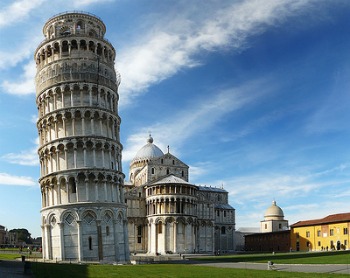 While the amount each traveler spends on the “what to do” portion of an Italy trip will vary significantly depending on what’s on that traveler’s to-do list, it’s at least easy to figure out a better-than-rough estimate before you get there – you can look up the admission prices online or in a good guidebook for the main museums, galleries, monuments, and other attractions you know you want to include in your itinerary.
While the amount each traveler spends on the “what to do” portion of an Italy trip will vary significantly depending on what’s on that traveler’s to-do list, it’s at least easy to figure out a better-than-rough estimate before you get there – you can look up the admission prices online or in a good guidebook for the main museums, galleries, monuments, and other attractions you know you want to include in your itinerary.
Sometimes the top attractions in a given city are free – including St. Peter’s Basilica in the Vatican, St. Mark’s Basilica in Venice, and the Duomo in Milan – which is always music to the ears of a budget-conscious traveler. Churches throughout Italy contain art that would be the masterpiece of many museums, and in most cases you can get in for free or for a small donation (which is why poking your head into just about any church that looks open is always a good idea, regardless of whether or not you know what’s inside).
Most cities (including Rome, Venice, and Naples) have special passes that include several attractions and (sometimes) transportation around the city, so if you’re staying in one place for more than 24 hours it’s definitely worth looking into – check online, in a good guidebook, or with that city’s tourist information office to find out whether there are tourist passes and what they’ll get you.
Also keep in mind that if you take a guided tour anywhere, reserve a couple euro coins to tip your guide – even if you paid for the tour, tipping a guide who’s done a good job is the right thing to do.
What will attractions cost in Italy?
For a few points of reference – a ticket to get into the Colosseum in Rome costs €12, a ticket for the Vatican Museums costs €13, a ticket to climb the Leaning Tower of Pisa is €15, a ticket to the Uffizi in Florence is €6.50, a ticket to see The Last Supper in Milan is €6.50, and a ticket to get into Pompeii is €11.
>> Further reading: What to Do in Italy, Free Things to Do in Italy, Discount Passes for Rome, Discount Passes for Venice
Shopping
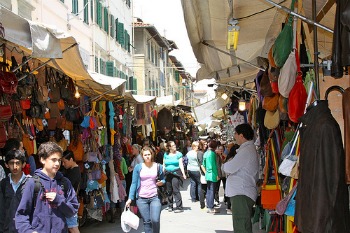 Only you can determine how much you intend to spend on souvenirs, clothing, and other trinkets when you’re in Italy. It can be hard to resist the pull of that pretty Prada store in Milan’s Galleria, but in this case the old adage applies – if you have to ask how much it is, chances are you can’t afford it.
Only you can determine how much you intend to spend on souvenirs, clothing, and other trinkets when you’re in Italy. It can be hard to resist the pull of that pretty Prada store in Milan’s Galleria, but in this case the old adage applies – if you have to ask how much it is, chances are you can’t afford it.
In popular tourist cities, there are street vendors with carts that overflow with cheap souvenirs and postcards; they’re often cheaply made (in China, of course) and may not be worth even the few euro they’re charging. You can often find great souvenirs at the outdoor markets that pop up once or twice a week on the streets of most cities around Italy, including clothing, handbags, and even shoes – but if it’s miniature gondolas or Davids you’re looking for, you’ll pretty much only find those in the tourist-oriented shops.
Do a bit of research before you go to Italy to find out what the cities and regions you’ll visit are known for product-wise, as it may be an excellent opportunity to pick up something on-site that would be several times the price back home. I’m talking here about things like ceramics from Deruta or glass from Murano – things that are big-ticket items even if you buy them in Italy. Remember to read up on how much you can bring back home with you before you’ll pay an import tax on it, however.
What will shopping in Italy cost?
Only you can determine the answer to this one, my friends!
>> Further reading: Shopping in Italy, Outlet Shopping in Italy, Duty Free Exemptions for Italy, How to Get a VAT Refund in Italy
Where I Think it’s Good to Splurge
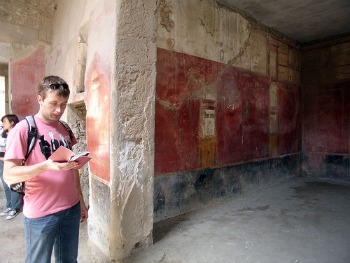 I’m not about to deprive myself of a travel experience just because the pricetag is more than I’d normally pay – if I think it’s worth it. Of course, what defines whether something is “worth it” or not is completely subjective. While I’m happy to pay what others might consider exorbitant prices for a stellar meal, I balk at paying more than €100/night in most hotels (I’ve stayed in some questionable places as a result, too).
I’m not about to deprive myself of a travel experience just because the pricetag is more than I’d normally pay – if I think it’s worth it. Of course, what defines whether something is “worth it” or not is completely subjective. While I’m happy to pay what others might consider exorbitant prices for a stellar meal, I balk at paying more than €100/night in most hotels (I’ve stayed in some questionable places as a result, too).
You know yourself best, so you’ll be able to figure out what areas of your budget – which categories listed above – you’re comfortable scrimping on and which you’d like to splurge on. Generally speaking, however, here are a few areas where I think a splurge is worth the extra money.
- Venice hotels – Venice is one of those cities where it really is worth it to pay more and stay right on the islands. It’s still not a “pay more and you’ll get more” situation – you’ll be paying more for a 2-star hotel in Venice than you might for a 3-4 star hotel in Naples – but this splurge is all about location. It’s cheaper to stay on the mainland, but you miss out on many of the things that make Venice wonderful. If you’re seriously strapped, stay just one night on the islands, in the cheapest place you’re comfortable with (and yes, there are hostels in Venice, too!).
- Tour guides – I can’t say enough how much a good tour guide can make an already amazing attraction that much better. You can do self-guided tours of Pompeii and the Vatican Museums, and you can appreciate cities like Venice and Naples just by wandering with your thoughts. But there is absolutely nothing like an engaging tour guide explaining not only what things are but why you should care to make any of those experiences exponentially more meaningful. Personally, I love (and can’t recommend highly enough) Context Travel’s tours in Italy, and there are lots of great individual tour guides in just about every Italian city.
- Transportation, sometimes – I love public transport in Italy, and regularly use the public trains and buses to get to and from airports and train stations to wherever I’m staying in that city. I once dragged two not-terribly-small suitcases for a two-month stay in Milan through the city’s Metro system and then on a 20-minute walk from the nearest station to the hotel – and I have since learned my lesson. When I’m carrying luggage of any kind, unless it’s a small day pack, and especially if I don’t know a city or I’ve just arrived after a long travel day, I’m usually quite willing to splurge on a taxi to get where I need to go. Yes, I’ll still take a train or a coach from the airport into the city center, but from there to my hotel? Taxi, please. I’ll spend a bit more cash for that option, and what I save in personal hassle and discomfort makes it more than worth it in my book. In other words, don’t beat yourself up if you wait until your second day in Italy to figure out the city’s bus system!
What’s your favorite splurge in Italy?
photos, top to bottom, by: Eric Caballero, Kok Vermeulen, gnuckx, jimmyweee, nikkigomez, M4rvin, brianandjaclyn, ivan.kovpak